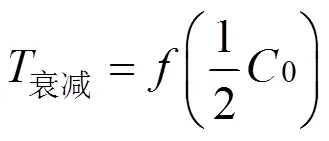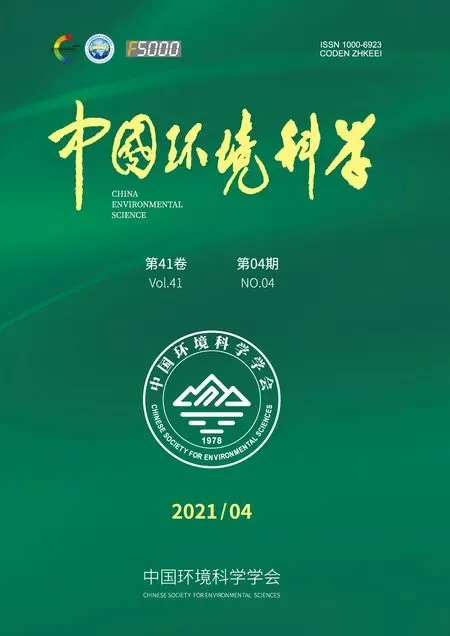典型室内公共场所灰尘中PBDEs污染特征及源解析
金漫彤,陆朱豪,郦林军,沈学优,张顺飞
典型室内公共场所灰尘中PBDEs污染特征及源解析
金漫彤1*,陆朱豪1,郦林军1,沈学优2,张顺飞1
(1.浙江工业大学环境学院,浙江 杭州 310014;2.浙江大学环境与资源学院,浙江 杭州 310058)
为探索以多溴联苯醚(PBDEs)为代表的半挥发性有机化合物在典型室内公共场所中的污染特征及与材料的关系,在网咖、电子市场、建材市场、商场和图书城5类典型公共场所采集分析了灰尘样品,利用环境模拟舱研究了不同污染源材料中PBDEs的挥发强度系数(vsPBDEs)、衰减半衰期,结合主成分分析(PCA)分析了PBDEs的浓度与不同室内材料间的关系.结果表明,杭州5类典型室内公共场所灰尘中∑14PBDEs的平均值分别为:网咖(2471.75ng/g)>电子市场(1071.77ng/g)>建材市场(900.63ng/g)>商场(441.27ng/g)>图书城(243.36ng/g).所选取的10种室内典型污染源材料中∑14PBDEs含量最高的为保温棉(91.61μg/g),最低的为电路板(7.97μg/g);vsPBDEs最高的为电线[14.04´104μg/(g×m2)],最低的是纤维墙纸[0.87´104μg/(g×m2)];塑料地毯、保温棉和纤维墙纸在40℃下的衰减半衰期分别为192,375和61d.研究发现室内公共场所中PBDEs的浓度与不同材料有关:网咖中PBDEs主要来自于纤维墙纸和电线;超市和图书城中PBDEs主要来自于陶瓷阻燃布和混纺地毯;建材市场中PBDEs主要来自于保温棉、电路板和塑料墙纸;电子市场中PBDEs主要来自于纤维阻燃布和电线.
多溴联苯醚;污染特征;污染源材料;挥发强度系数;半衰期
溴系阻燃剂因其阻燃效果好、价格低廉而被广泛使用[1-2],其中多溴联苯醚(PBDEs)是一类重要添加型溴系阻燃剂,因其阻燃性能优异且对材料性能影响小,被广泛应用于各类消费产品中[3],电子产品的塑料高聚物中,PBDEs含量可达到5%~30%[4].目前,工业上使用的多溴联苯醚包括五溴(Penta- BDE)、八溴(Octa-BDE)及十溴联苯醚(Deca-BDE)3类[5-6].尽管斯德哥尔摩公约已将五溴和八溴联苯醚纳入持久性有机污染物禁止其生产和使用,但过去20a生产的含PBDEs的阻燃剂产品仍在使用.由于PBDEs易于从消费产品中挥发出来,进而被空气悬浮颗粒物所吸附,或通过物理磨损以及灰尘的直接接触,也易于将PBDEs带入灰尘中[7-8].PBDEs的3种工业品中,Penta-BDE的毒性最大,较低的剂量就可以产生生物毒效应[9],其次为Octa-BDE和Deca- BDE[10-11].
人的一生中约有80%时间在室内环境中度过[12],人们日常生活中,会通过呼吸、饮食以及皮肤吸收等多种途径吸入含有多溴联苯醚的灰尘[13-15].会影响人类的甲状腺系统、雌激素系统和肝脏脂肪酸代谢系统[16-17],从而对人体健康造成危害.办公室内和家庭等室内环境中的PBDEs浓度大于室外,其中办公室污染较严重[18].据统计,美国、加拿大、波兰和希腊等发达国家室内灰尘中PBDEs浓度较高,尼泊尔等发展中国家室内灰尘中PBDEs浓度较低[19-24],这可能与发达国家较早使用含PBDEs的家具有关.国内研究发现,上海,深圳和杭州等一线城市办公场所灰尘中PBDEs浓度较高,上海办公室颗粒物中PBDEs浓度为(3361.6±1987.4)ng/g,深圳某办公楼灰尘中Σ14PBDEs总量达到141pg/kg,杭州行政办公场所空气中PBDEs浓度高达957pg/ m3[25-27],可能与办公场所中有较多的桌椅和装饰材料有关.这与文献[28-29]研究室内灰尘中PBDEs,得出其浓度可能跟室内泡沫家具、地毯、PUF床垫、合成床枕头以及部分装饰品等使用有关相一致.进一步监测和研究发现,室内不同材料中含有不同浓度的PBDEs[31].
Athanasios等[31]进一步研究发现墙纸(28.7mg/g)、塑料板(51.51mg/g)、保温棉(101mg/g)等装饰材料中都含有较多的PBDEs,因此商场、网咖、图书城等典型室内流动微环境或将逐渐成为危害人体健康的环境新因素.目前大部分研究主要是针对家庭和办公室区域,而对人员密度较大的室内公共场所的研究较少,本文以14种PBDEs单体为研究对象,对杭州市5类典型室内公共场所环境灰尘进行实地采样,并检测其中PBDEs的浓度的基础上,探究多种典型室内污染源材料中PBDEs对环境的影响,通过环境模拟舱研究其半衰期,结合PCA进行了源分析,探究不同典型室内PBDEs浓度与材料的关系,为有效控制室内PBDEs污染提供理论支持.
1 材料与方法
1.1 实验仪器与试剂
CTHI-250B2 恒温恒湿箱(上海施都凯仪器设备有限公司);Agilent7890B 气相色谱仪及 Agilent DB-5 122-5011(15m×250μm×0.1μm)毛细管色谱柱;RE-52AA旋转蒸发仪(上海亚荣生化仪厂); MTN-2800W氮吹浓缩装置(天津奥特赛恩斯仪器有限公司); SHB-Ⅲ循环水式多用真空泵(河南太康科教器材厂);SX3-2-12X 节能纤维电阻炉(杭州卓驰仪器有限公司);ZH-D全温摇床(常州澳华仪器有限公司);250mL蛇形索式提取器;PBDEs混合标准样品购于美国Accustandards Inc.(New Heaven, USA);6.4cm(直径)×7.5cm圆柱形聚氨酯泡沫(PUF);玻璃纤维滤膜(GF).用于样品前处理的试剂有正己烷、二氯甲烷、丙酮、无水Na2SO4,均为分析纯;用于定容的正己烷为色谱纯;99.99%高纯氮气;200~ 300目硅胶.
1.2 采样点与污染源
本文按PBDEs潜在的污染来源选择建材市场、电子市场、网咖、图书城和商场5类室内公共场所作为研究对象,其中设置的采样点数及采样量见表1.

表1 采样点数及采样量
取场所内均有的目标物污染源为纯毛地毯、混纺地毯、塑料地毯、纤维阻燃布、陶瓷阻燃布、保温棉、电线、电路板、纤维墙纸、塑料墙纸.
1.3 样品采集方法
采用表面擦拭法收集灰尘样品,即使用洁净的毛刷刷取室内灰尘.环境模拟舱如图1,实验前对环境模拟舱进行检漏,在各接口处涂抹检漏液,并向环境模拟舱内通入氮气,直至无气泡产生后保持通气10min,以排除环境模拟舱内空气的干扰.称取8g污染源材料,由于不同材料表面积大小不均,以墙纸为例,将其剪成2个大长块,2个小长块,每2个长块面积都相等,用经正己烷-丙酮混合溶液(体积比1:1)索氏提取后的细棉线将其两两绑紧,使每块板都只有一面直接暴露在空气中,将其放置于预先洗净晾干的1000mL烧瓶内,塞子周边用封口膜封紧,放置在恒温恒湿箱内,设定温度(40℃),每隔3d取一次样.每个样品从恒温恒湿箱取出后,取下环境模拟舱如图1(a)中间的玻璃塞并迅速套上放有PUF的玻璃装置,在玻璃二通阀处连上氮气管,如图1(b),氮气流量控制在250mL/min,通气1h,保证封闭空间内的料释放到空气中的PBDEs被PUF充分吸收,以测得不同PBDEs挥发强度系数的污染源材料的 PBDEs对释放浓度水平.

图1 PBDEs释放环境模拟舱
1.4 样品预处理
将目标物用GF包好置于索式提取器的索提管中,向平底烧瓶中加入200mL正己烷-丙酮混合溶液(体积比1:1),设置温度在55℃左右避光条件下提取24h.向提取液中加入20mL分析纯正己烷溶剂置换,旋转蒸发至1~2mL;将浓缩液加入层析柱内(层析柱从下至上分别填入1g活性硅胶、2g酸性硅胶、1g活性硅胶、2g酸性硅胶、2g活性硅胶,最后在层析柱最上层填入2g无水Na2SO4),用40mL正己烷和二氯甲烷混合液(体积比1:1)淋洗3次;层析净化后在收集液中加入20mL色谱纯正己烷置换溶剂3次,蒸发浓缩至1~2mL;浓缩后用柔和的N2吹扫近干,加入2mL色谱纯正己烷重复2次,最后加入色谱纯正己烷定容至500μL,移至棕色色谱瓶中保存.
1.5 仪器分析
使用Agilent 7890B(配GC-µECD)分析预处理完的样品.脉冲进样压力为 36psi(1标准大气压=14.696psi),进样口温度270℃,检测器温度320℃,初始温度100℃(保持1min),以25℃/min升温至200℃,再以5℃/min升温至280℃,最后以15℃/min升温至315℃(保持4min),进样量1µL(不分流进样),流速 2.0mL/min的高纯N2为载气.
1.6 质量保证与质量控制
本实验根据样品中PBDEs浓度范围绘制双量程标准曲线,低量程(1,2,5,10,20μg/L)和高量程(20,40, 50,100,200μg/L).为确保数据可靠性,仪器每次开关机后需重新绘制标准曲线;每检测10个样品,用20μg/L标准溶液进行一次仪器校正,当校正溶液信号偏差大于5%时,需重新绘制标准曲线.
本实验每10个样品一组设置1个空白样,实验过程和样品处理完全相同.从样品分析结果中扣除空白值,空白实验结果14种PBDEs的含量均低于检出限.
本文中GF及PUF上各PBDEs的回收率均在80%~120%之间,且相对标准偏差小于10%,满足物质定量分析的要求.本实验涉及的仪器分析是典型的痕量样品检测问题,为确保检测结果的准确性,确定了仪器检出限和方法检出限.各单体仪器检出限为0.0083~0.0489μg/L,方法检出限为0.0130~0.069ng/g.
2 结果与讨论
2.1 室内灰尘中PBDEs的浓度水平
5类场所灰尘中PBDEs浓度如表2所示.
建材市场、电子市场、网咖、图书城和商场中∑14PBDEs的浓度可见表2.其中网咖中∑14PBDEs的浓度最高,约是图书城的10倍,可能因为各类电子电器内部元件组成复杂,且电路板属易燃物,故在电器的塑料外壳表面和内部的电路板表面均会添加大量的PBDEs.而由于大量电子产品高频使用,且采样点的网咖多通风不佳,PBDEs浓度远高于大部分产品处关机状态的电子市场.而建材市场主要出售各类建筑装潢材料,为了尽可能避免造成火灾带来的损失,在各类建筑材料中也常有PBDEs添加.商场中的PBDEs则来源于部分区域有限的建筑材料的挥发散逸,以及服装区中添加于衣物纺织材料中和制鞋、箱包皮革的阻燃剂中,因污染源相对有限,所以PBDEs浓度仅次于建材市场.图书城中污染源比较有限,大部分来源于书架等木制品表面,浓度相对其他4个场所最低.这与文献[29,31]的研究发现一致,室内灰尘中PBDEs浓度与泡沫家具、电子产品数量呈正相关.

表2 五类公共场所灰尘中PBDEs含量(ng/g)
注:N.D表示未检出,下同;∑13PBDEs表示除BDE-209外的13种单体含量之和,下同.

图2 5类场所灰尘中PBDEs同系物分布
如图2所示,PBDEs各同系物在不同场所中所占比例各不相同,说明PBDEs在室内灰尘中的分布不均,其中BDE-209在各个场所中所占比例均最高,分别为65.52%、61.34%、72.00%、58.79%和51.21%.不同的室内环境中,PBDEs同系物组成上存在着较大的差异.
2.2 典型材料中PBDEs的含量及挥发强度系数
通过环境模拟舱模拟10种典型材料中PBDEs的挥发过程,通过测量相邻两次材料浓度的差值计算材料中PBDEs的挥发量,重复测10次并去掉极端值,计算平均值.表3给出了10种目标物中14种PBDEs同系物单体的含量.
如图3所示,BDE-100在纯毛地毯和塑料墙纸中未被检出,BDE-154在纯毛地毯和混纺地毯中未被检出.BDE-85在塑料墙纸中未被检出,其余种类在目标物中均有测出.目标物中PBDEs含量最高的是保温棉,最低的是电路板,分别为91.61和7.97μg/g,说明不同目标物中主要单体种类也存在差异.

表3 各材料中PBDEs含量(mg/g)

图3 10种目标物中不同PBDEs同系物的比例

表4 各材料的PBDEs挥发强度系数KvsPBDEs[mg/(g×m2)]
本文分析计算了每种材料挥发强度系数[32]

式中:C表示污染源中PBDEs的含量,μg;表示污染源的质量,g;表示污染源暴露在空气中的有效表面积,m2,结果如表4所示,在40℃下挥发强度系数大小为:电线>塑料地毯>电路板>保温棉>混纺地毯>纯毛地毯>陶瓷阻燃布>塑料墙纸>纤维阻燃布>纤维墙纸,电线和塑料地毯属于挥发系数较大的目标物,纤维阻燃布和纤维墙纸属于挥发系数较小的目标物.
2.3 典型材料中PBDEs的半衰期研究
半衰期是研究半挥发性有机污染物的一个重要参数,运用环境舱模拟实验的方法对典型污染源材料中PBDEs的半衰期进行研究(主要影响因素为封闭时间和材料中PBDEs挥发强度系数).以塑料地毯、保温棉和纤维墙纸作为研究对象来确定污染源材料中PBDEs含量的衰减函数.分别将塑料地毯、保温棉和纤维墙纸平整铺盖在3个环境舱内,并设置空白对照组,放置在恒温恒湿箱中进行恒温操作.温度设置为40℃,每隔3d取出环境舱内的样品的一部分对其PBDEs含量进行检测,重复实验3次,去除极端数据,取总PBDEs浓度的平均值,结果见表5.
陈伟东[34]研究塑料制品中PAEs的半衰期,发现了也有相似的规律,因此本文参考了其定义的衰减半衰期:

式中:是半衰期,d;0是污染源材料中PBDEs的初始含量,μg/g;是通过实验数据拟合的污染源材料中PBDEs含量的衰减函数.

表5 3种研究材料的PBDEs含量随时间变化趋势(mg/g)
Zhu等[35]通过环境舱模拟实验,分别用线性衰减模型和幂律衰减模型对实验数据进行拟合,比较发现前者在衰减时间较长的情况下,其相关性低于后者与实验数据拟合的相关性.初步确定选用幂律衰减模型作为污染源材料中PBDEs含量的衰减函数.其中幂律衰减模型表达形式如下:

式中:为污染源材料的PBDEs含量,μg/g;是扩散时间,d;是初始值;是衰减常数.
用幂律衰减模型对上述实验数据进行拟合,得到40℃下塑料地毯、保温棉和纤维墙纸三种材料中的PBDEs含量的衰减函数如表6所示.

表6 3种污染源材料40℃下衰减半衰期参数表
将表6中的参数代入衰减半衰期的公式中,3种典型污染源材料在40℃下的衰减半衰期如表7所示.

表7 3种污染源材料40℃下衰减半衰期
注:vs平衡是计算得到平衡状态下材料的PBDEs挥发强度系数;Δvs是vs和vs平衡的差值;k是单位时间衰减半衰期的Δvs值.
通过表6可以直观发现在40℃下,污染源材料中PBDEs初始含量高的值越大,值越大,污染源材料的PBDEs挥发强度系数越小,幂律衰减模型的拟合效果越好.从表7可以发现,塑料地毯、保温棉和纤维墙纸在40℃下的衰减半衰期分别为191.94d, 374.9d和61.33d.通过分析比较挥发强度系数和值,可以看出污染源材料的挥发强度系数越大,污染源材料在单位质量单位表面积下每天所释放的PBDEs浓度水平越高.
2.4 5类典型公共场所中PBDEs的主要污染源分析
为了更直观的了解每个场所的主要污染源,对5类场所中典型材料挥发的PBDEs与5类场所灰尘中PBDEs浓度进行PCA分析.分别对5个场所各污染物单体数据、10种材料污染物单体数据进行PCA降维分析,对场所的降维数据以点的形式展示,而材料以向量形式展示.
图4中间5个区域分别表示超市、电子市场、建材市场、图书城和网咖.网咖区域与纤维墙纸和电线更接近,表明网咖中PBDEs主要来自于纤维墙纸和电线,同理超市和图书城中PBDEs主要来自于陶瓷阻燃布和混纺地毯,建材市场中PBDEs主要来自于保温棉、电路板和塑料墙纸,电子市场中PBDEs主要来自于纤维阻燃布和电线.在10种材料中,保温棉、纤维阻燃布和电路板是PBDEs主要污染源,这3类材料主要在建材市场、电子市场和网咖,所以这3类场所的PBDEs浓度较高,其中网咖中有较多的电线,电线表面的阻燃剂添加较多,所以网咖∑14PBDEs的浓度最高,建材市场和电子市场中这3类材料相对较少,所以浓度比网咖较低且它们的浓度差距不大.

图4 5类公共场所中主成分分析比较
3 结论
3.1 杭州5类典型室内公共场所灰尘中∑14PBDEs的平均浓度,网咖>电子市场>建材市场>商场>图书城,污染程度最高的网咖是最低图书城的10倍.
3.2 所选取的10种室内典型污染源材料中∑14PBDEs含量最高的是保温棉,最低的是电路板,分析测定了10种室内典型污染源材料的PBDEs挥发强度系数vsPBDEs,其最大的为电线vsPBDEs值为14.04×104μg/(g×m2),最小的纤维墙纸vsPBDEs值为0.87×104μg/(g×m2),确定了塑料地毯、保温棉和纤维墙纸在40℃下的衰减半衰期分别为192d,375d和61d.
3.3 PCA分析表明了PBDEs的浓度与不同室内材料有关,网咖中PBDEs主要来自于纤维墙纸和电线,超市和图书城中PBDEs主要来自于陶瓷阻燃布和混纺地毯,建材市场中PBDEs主要来自于保温棉、电路板和塑料墙纸,电子市场中PBDEs主要来自于纤维阻燃布和电线.
[1] Troitzsch J H . Overview of flame ret-ardants, fire and fire safet markets and applications, mode of action and main families, role in fire gases and residues [J] .Chem Today, 1998,16(1):18-24.
[2] Hirai Y, Sakai S. Brominated flame rerdants in recycled plastic products [Z]. Amsterdam:4th International Workshop on Brominated Flame Retardants, 2007.
[3] 黄玉妹,陈来国,文丽君,等.广州市室内尘土中多溴联苯醚的分布特点及来源[J]. 中国环境科学, 2009,29(11):1147-1152. Huang Yumei, Chen Laiguo,Wen Lijun, et al.Distribution and possible sources of PBDEs in indoor dust in Guangzhou City [J]. China Environmental Science, 2009,29(11):1147-1152.
[4] Fischer D, Hooper K, Athanasiadou M, et al. Children show highest levels of polybrominated diphenyl ethers in a California family of four: A case study [J]. Environmental Health Perspectives, 2006,114(10): 1581-1584.
[5] Toms L M, Hearn L, Kennedy K, et al. Concentrations of polybrominated diphenyl ethers (PBDEs) in matched samples of human milk, dust and indoor air [J]. Environment Internat-ional, 2009,35(6):864-869.
[6] Hites R A. Polybrominated diphenyl e-thers in the environment and in people: a metanalysis of concentrations [J]. Environmental Science & Technology, 2004,38(4):945-956.
[7] Fromme H, Becher G, Hilger B, et al. Brominated flame retardants Exposure and risk assessment for the general population [J]. International journal of hygiene and environmental health, 2016,19(1): 1-23.
[8] Takigami H, Suzuki G, Hirai Y, et al. Transfer of brominated flame retardants from components in-to dust inside television cabinets [J]. Chemosphere, 2008,73(2):161-169.
[9] Wang H, Tang X X, Sha J J, et al. The reproductive toxicity on the rotifer Brachionus plicatilis induced by BDE-47 and studies on the effective mechanism based on antioxidant d-efense system changes [J]. Chemosp-here, 2015,135:129-137.
[10] Xie X C, Qian Y, Wu Y, et al. Effects of decabromodiphenyl ether (BDE-209) on the avoidance response, survival, growth and reproduction of earthworms (Eisenia fetida) [J]. Ecotoxicology and Environmental Safety, 2012,90:21-27.
[11] Wang Q G, Chen Q, Zhou P, et al. Bioconcentration and metabolism of BDE-209 in the presence of titaniu-m dioxide nanoparticles and impact on the thyroid endocrine system and neuronal development in zebrafish larvae [J]. Anotoxicology, 2014,8(S-1):196-207.
[12] Romsgnili P, Balducci C, Perillli M, et al. Indoor PAHs at schools,homes and offices in Rome, Italy [J]. Atmospheric Environment, 2014,92:51-59.
[13] Yadav I C, Devi N L, Zhong G C, et al. Occurrence and fate of organophosphate ester flame retardants and plasticizers in indoor air and dust of Nepal: Implication for human e-xposure [J]. Environment Pollution, 2017,229:668-678.
[14] Chen M Q, Jiang J Y, Gan Z W, et al. Grain size distribution and exposure evaluation of organophosphorus and brominated flame retardants in indoor and outdoor dust and PM10from Chengdu, China [J]. Journal of Hazar-dous Materials, 2019,365:280-288.
[15] Tian M, Chen S J, Wang J, et al. Atm-ospheric deposition of halogenated flame retardants at urban,Ewaste, and rural locations in southern China [J]. Environment Science & Technology, 2011,45(11): 4696-4701.
[16] Lignell S, Aune M, Darnerud P O, et al. Prenatal exposure to polychlorinated biphenyls (PCBs) and polybrominated diphenyl ethers (PBDEs) may influence birth weight among infants in a Swedish cohort with backgro-und exposure: A cross-sectional study [J]. Environmental Health, 2013,12(1):44-52.
[17] 任肖敏,张连营,郭良宏.多溴联苯醚和全氟烷基酸的分子毒理机制研究 [J]. 环境化学, 2014,33(10):1662-1671.Ren Xiaomin, Zhang Lianying, Guo Lianghong. Molecular mechanism study on the toxicological effects of polybrominated diphenyl ethers and perfluoroalkyl acid [J] Environmental Chemistry, 2014,33(10):44-52.
[18] 蒋欣慰,孙 鑫,裴小强,等.杭州市办公场所室内空气中PBDEs的污染现状与特征[J]. 环境科学, 2014,35(1):41-45.Jiang Xinwei, Sun Xin, Pei Xiaoqiang, et al. Pollution Status and Characteristics of PBDEs in Indoor Air of Hangzhou [J]. Environmental Science, 2014,35(1):41-45.
[19] Yadav I C, Devi N L, Singh V K, et al. Measurement of legacy and emerging flame retardants in indoor dust from a rural village (Kopawa) in Nepal: Implication for source apportionment and health risk assessment [J]. Ecotoxicology and Environmental Safety, 2019, 168:304-314.
[20] Fromme H, Krner W, Shahin N, et al. Human exposure to polybrominated diphenyl ethers (PBDE), as evidenced by data from a duplicate diet study, indoor air, house dust, and biomonitoring in Germany [J]. Environment International, 2009,35(8):1125-1135.
[21] Kurt-Karakus P B, Alegria H, Jantunen L, et al. Polybrominated diphenyl ethers (PBDEs) and alternative flame retardants (NFRs) in indoor and outdoor air and indoor dust from Istanbul Turkey: Levels and an assessment of human exposure [J]. Atmosp-heric Pollution Research, 2017,8(5):801-815.
[22] Besis A, Katsoyiannis A, Botsaropoulou E, et al. Concentrations of polyb-rominated diphenyl ethers (PBDEs) in central airconditioner filter dust and relevance of nondietary exposure in occupational indoor environment in Greece [J]. Environmental Pollution, 2014,188:64-70.
[23] Veniner M, Audy O, Vita, et al. Brominated flame retardants in the indoor environment Comparative study of indoor contamination from three countries [J]. Environment International, 2016,94:150-160.
[24] 白春蕾,解春宵,李 科.室内环境中多溴联苯醚的污染特征和暴露风险研究进展[J]. 环境化学, 2019,38(12):2736-2745. Bai Chunlei, Xie Chunxiao, Li Ke. The pollution characteristics and exposure risk of polybrominated diphenyl ethers (PBDEs) in indoor environment [J]. Environmental Chemistry, 2019,38(12):2736-2745.
[25] Ni Honggang, Cao Shanping, Chang Wenjing, et al. Incidence of polybrominated diphenyl ethers in central air conditioner filter dust from a new office building [J]. Environmental Pollution, 2011,159(7): 1957-1962.
[26] 韩文亮,冯加良,彭小霞,等.上海室内环境中多溴二苯醚的沉降通量与组成 [J]. 环境科学, 2010,31(3):579-585. Han Wenliang, Feng Jialiang, Peng Xiaoxia, et al. Indoor Deposition Flux and Congener Profiles of Polybrominated Diphenyl Ethers (PBDEs) in Shanghai, China [J]. Chinese journal of Environmental Science, 2010,31(3):579-585.
[27] 金漫彤,郑艳霞,胡张璇,等.行政办公室内PBDEs污染特征及人体暴露量 [J]. 中国环境科学, 2015,35(10):3142-3149. Jin Mantong, Zheng Yanxia, Hu Zhangxuan, et al. Pollution characteristics and human exposure of PBDEs in offices [J]. China Environmental Science, 2015,35(10):3142-3149.
[28] Hitehead T P, Brown F R, Metayer C, et al. Polybrominated diphenyl ethers in residential dust: sources of variability [J]. Environment International, 2013,(57/58):11-24.
[29] Wit C A D, Björklund J A, Thuresson K. Tridecabrominated diphenyl ethers and hexabromocyclododecane in indoor air and dust from Stockholm microenvironments: Indoor sources and human exposure [J]. Environment International, 2012,39(1):141-147.
[30] 金漫彤,何嘉琪,郑子丹,等.典型污染源材料中多溴联苯醚(PBDEs)的释放 [J]. 中国环境科学, 2019,39(8):3233-3241. Jin Mantong, He Jiaqi, Zheng Zidan, et al. Release of PBDEs in typical source materials [J]. China Environmental Science, 2019,39(8): 3233-3241.
[31] Athanasios B, Athanasios Katsoyiannis, Elisavet Botsaropoulou, Constantini Samara. Concentrations of polybrominated diphenyl ethers (PBDEs) in central airconditioner filter dust and relevance of nondietary exposure in occupational indoor environments in Greece. [J]. Environmental Pollution, 2014,188:64-70.
[32] Muenhor D, Harrad S.Within-room and within-building temporal and spatial variations in concentrations of polybrominated diphenyl ethers (PBDEs) in indoor dust [J]. Environment International, 2012,47:23- 27.
[33] 池晨晨.室内空气中典型有机污染的来源、特征及规律 [D]. 杭州:浙江大学, 2016.Chi Chenchen. Sources, features and laws of the typical organic pollution in indoor air [D]. Hangzhou: Zhejiang University, 2016.
[34] 陈伟东.室内典型污染源中PAEs的释放半衰期及规律 [D]. 杭州:浙江大学, 2017.Chen Weidong. Release half-life and regularity of PAEs in typical indoor pollution sources [D]. Hangzhou: Zhejiang University, 2017.
[35] Zhu J P, Zhang J S, Shaw CY. Com-parison of models for describing me-asured VOC emissions from wood b-ased panels under dynamic chamber test condition [J]. Chemosphere, 2001,44(5):1253-1257.
Pollution characteristics and source analysis of PBDEs in dust in typical public places.
JIN Man-tong1*, LU Zhu-hao1, LI Lin-jun1, SHEN Xue-you2, ZHANG Shun-fei1
(1.College of Environment, Zhejiang University of Technology, Hangzhou 310014, China;2.College of Environmental and Resource Sciences, Zhejiang University, Hangzhou 310058, China)., 2021,41(4):1878~1885
In order to explore the pollution characteristics of SVOCs represented by polybrominated diphenyl ethers (PBDEs) in typical indoor public places and the relationship with materials, dust samples were collected and analyzed in 5 types of typical public places, PBDEs concentration in different indoor materials were analyzed by using environmental simulation cabin,then the coefficient of volatile strengths of PBDEs (vsPBDEs), decay half-life was determined. The relationship between the concentration of PBDEs and different indoor materials was analyzed by PCA. The results revealled that the concentration of ∑14PBDEs in dust in 5 typical Hangzhou indoor public places from high to low was: Internet cafes (2471.75ng/g), electronic markets (1071.77ng/g), building materials markets (900.63ng/g), shopping malls (441.27ng/g), and book cities (243.36ng/g). Among the selected 10 pollution source materials, the highest concentration of ∑14PBDEs was thermal insulation cotton (91.61μg/g), and the lowest was circuit board (7.97μg/g), the highestvsPBDEswas wire (14.04×104μg/(g×m2)), and the lowest was fiber wallpaper (0.87×104μg/(g×m2)), finally, plastic carpet, insulation and cotton fiber wallpapers ecay half-life (192,375,61d) at 40℃ were determined. It revealled that PBDEs concentration in indoor public places was related to different indoor materials. PBDEs in Internet cafes mainly come from fiber wallpaper and wires, PBDEs in shopping malls and book cities mainly come from ceramic flame-retardant cloth and blended carpets, PBDEs in the building materials markets mainly come from thermal insulation cotton, circuit boards and plastic wallpaper, and PBDEs in the electronic markets mainly come from fiber flame retardant cloth and wires.
PBDEs;pollution characteristics;source material;coefficient of volatile strengths;half-life
X502
A
1000-6923(2021)04-1878-08
金漫彤(1967-),女,浙江杭州人,博士,教授,主要研究方向为室内空气污染及控制.发表论文50余篇.
2020-08-18
国家重点研发计划项目(2016YFC0207103);浙江省自然科学基金资助项目(LY16B070012)
* 责任作者, 教授, jmtking@zjut.edu.cn

